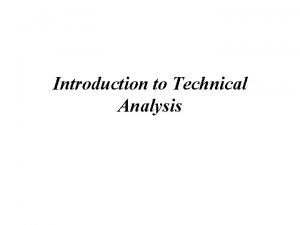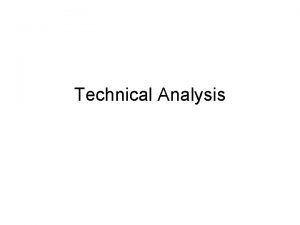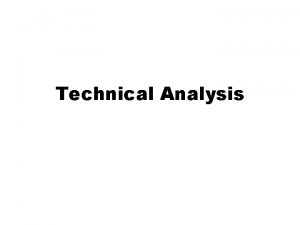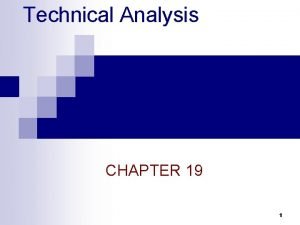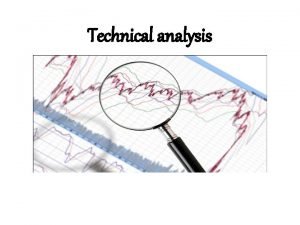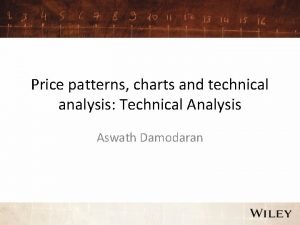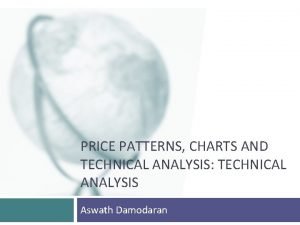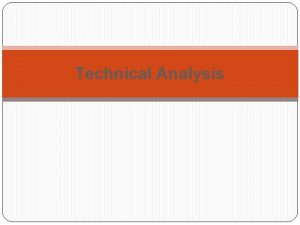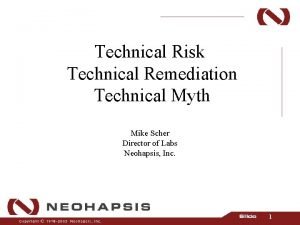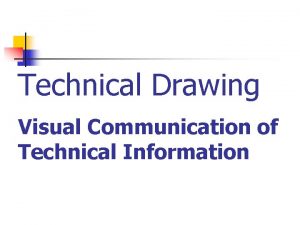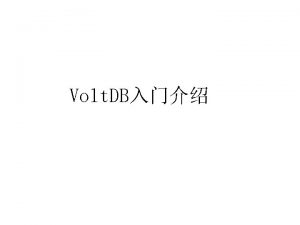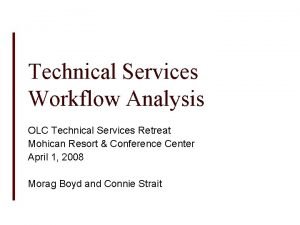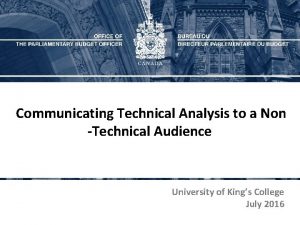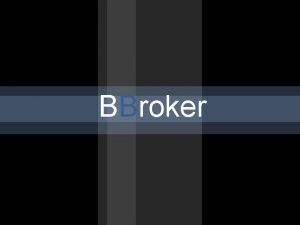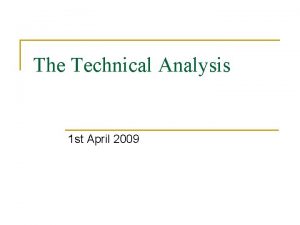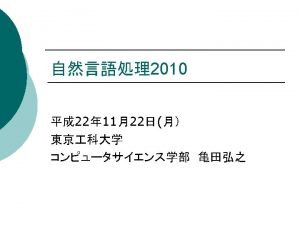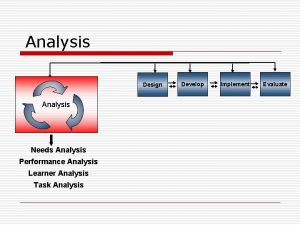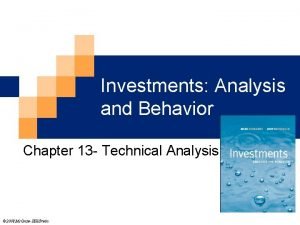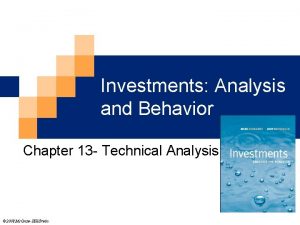The Technical Analysis Technical Analysis n n n













































- Slides: 45

The Technical Analysis

Technical Analysis n n n The oldest way of asset analysis. Some principles and processes of technical analysis were used in the Asia rice market since the 18 th century. Modern history of technical analysis is related with Charles H. Dow (1851 -1902). q q William Hamilton Robert Rhea n n Dow theory during 30 years Others: q q W. D. Gann that earned more than 50 millions dollars using by own principles and methods known as a Gann Theory. According to angles in charts he looked for moments when trend is going to turnover. R. Elliont n The Elliont waves q A bull market is divided in three phases § 5 bull waves § 3 bear waves § A classical pattern that is repeated and can be called a cycle

Background n Technical analysis is the method that want to predicted a future development of market by trends and the chart researches. q Basic information sources are n n n Development of security prices Volume of trade Development of market indices

Technical Analysis n The criticism of fundamental analysis q q The intrinsic value is not able to describe the real situation in the capital market because is not able to describe psychological aspects and other nonfundamental and technical aspects. Technical analysis does not interest in fundamental factors that influence security price but focus on activity and movement in the market. n Believe that there exist factors that have an impact on the security price but they are q q with unpredictable character and that are not covered by fundamental analysis that

Technical Analysis n n Technical analysis is summarized in three thesis: 1. Security prices mirror all known information. But reaction of security rate to new information is n n q q gradual and slow This gradual process of adjustment of some new information leads to a market trend. Technical analysis n n does not care about reasons of the security price movement but about this movement in itself.

Technical Analysis n 2. There have been the patterns of security rate movements. q n If they are successful and in time recognize kind of the pattern they are able to prognoses future development of security rate. 3. History is repeated q q More than 100 years technical analyzers have been looking for patterns they classified and confronted them. As the result they persuaded that the most of the patter is repeated because human behavior repeated as well.

Technical Analysis n According to the main mentioned thesis there are some problems in TA application q q q History is not repeated exactly and investor can not expect exact repeating of patterns. It leads to subjective opinion of analyzer and inaccuracy of analysis results. It means that result of analysis is only n a framework that n happened with particular probability. The technical analysis answers the question: n When and what is going to happen -> it means that it is used for timing n In contrast to fundamental analysis that TA is not used for stock picking (technical analysis is not able to find over or under estimate securities)

Technical Analysis n Main advantages q q q It is not data-intensive The background of basic methods uses by technical analysis is simple Methods of technical analysis can by apply in any market n n n Securities Commodities or Exchange currencies

Dow Theory n On the basis of security prices study assumed conclusion that q q q As market barometry can be used the average closing rate of particular securities. This can be used as a benchmark of a whole market performance. First application in 1884 - Railroad Average first index composes of 11 stocks (9 stocks of railroad companies) In 1896 Dow created new index because Railroad Average was able to describe only part of the economy because of limited number of sector securities. Dow Jones Industrial Average - average of closing prices of 12 securities n n q q q Highly speculative Industry companies In 1928 basis of DJIA extended to 30 securities. Value of DJIA first published in Wall Street Journal in May 1896 its value was 40, 96 points (that days 9. 800 points) Former Railroad Average is still used and it is known as a Dow Jones Transportation Average (DJTA).

Dow Theory n n n Study of historical performance of capital market gave him an evidence that averages of security price are moved in trends. The most of the securities in the market have similar development. The market performance can be describe by using of indices. All relevant factors that influence supply and demand are absorbed by index. q Index represents an accurate image of the situation in the market.

Main ideas of Dow Theory n Indexes that are created as an average of closing prices of securities includes all relevant information. q n main thesis of technical analysis Movement of stock rates can be divided in three basic trend movements q q q Primary – takes one year or more and it is consider to be a main trend or main way of development. Secondary - takes from 3 weeks to 3 months. It is consider to be reverse to the development of the main trend. Tertiary – the shortest trend less then 3 weeks. It is consider to be insignificant development in primary or secondary trend.

Main ideas of Dow Theory

Main ideas of Dow Theory n Future development of security prices (it means continuing of trend or its turnover) can be derivate from the recent market situation q q Trend where peaks are rising it means the trend where every next peak is higher then previous peak and whose every bottom is higher then previous bottom is known as a rising trend or a Bull Trend where peaks and bottoms are declining it means trend whose every bottom is lower then previous and every peak is lower then previous is known as a declining trend or a Bear Trend.

Bull Trend

Bear Trend

Main ideas of Dow Theory n The turnover of trend occurs if q q q Rising sequence of peaks and bottoms is interrupted in case of Bull Trend Declining sequence of peaks and bottoms is interrupted in case of Bear Trend. In order to have an evidence of trend turnover is necessary to have interrupted sequence in both n bottoms and peaks.

Primary Trend

Main ideas of Dow Theory n 1. The main trend consists of three phases q These three phases can be identify in a bull as well as in a bear trend. n n n The best-informed investors start buying in situation when index reaches its bottom - accumulate phases Positive information about economy and profit grow this spreading. In Bull Trend is this phase characterized by the massive growth of capital market and is known as a growing phase. In this phase are trading institutional investors especially. In third phase there are trading especially retail investors. This phase is known as a distribution phase. At the end of this phase optimistic stock euphoria is over. Security price reaches its peak. Bull Trend is over and starts Bear Trend.

Main ideas of Dow Theory n 2. Volume of trade must confirm trend q q Volume of trade reflects total market activity with a particular instrument in a determine time. Volume of trade can be used as a supplement information that can confirms market signals. Trend is confirmed in the moment when the volume of trade is rising. The situation when volume of trade is decreasing it is signal of market weakness and investor can expect with high probability trend turnover.

Main ideas of Dow Theory n 3. The trend exists until in the market are signals of new trend q This principle contains basic aim of the technical analysis that is the identification of a trend turnover. n Tools q q Charting Technical indicators

Main ideas of Dow Theory q Main problems of Dow Theory n Signals that are identify by Dow theory come with adelay it means that investors drop potential profit at the beginning of every trend. q q Dow Theory is “Trend-Following” that reacts the circumstances then occurred The aim of Dow theory is to identify kind of primary trend and its turnover on the market as a whole. Dow theory is not able to offer sell or buy signals of a particular security. Dow theory is oriented only on primary market trend Dow theory is not able to define duration and power of primary trend.

Main ideas of Dow Theory n Despite of all problems Dow Theory is theoretical resource of technical analysis q q From 1897 -1991 Dow Theory delivered 40 correct signals of important market actions Wrong signals were only 5

Methods and tools of technical analysis n Charting q q Method base on using of charts to identify trend or its turnover and derive buy or sell signals. Analyzers looking for standardized formation by studying of security price development. n q Standardized formation is a pattern in security rate development. Standardized formation are emerged repeatedly and their correct identification can be used for the capital market prognoses.

Methods and tools of technical analysis n Two main formations q q n Consolidated formation that confirms trend, or Reverse formation that confirms turnover of trend The simplest tool how to find out trend is by Trend Line. q q In Bull Trend Line establishes if you put together local bottoms In Bear Trend Line establishes if you put together local peaks

Trend Line – Bull market

Trend Line – bear market

Methods and tools of technical analysis n Trend Line can be q q q n Importance and the precision of the prediction is determined by q q n Rising in the case of Bull Trend Declining in the case of Bear Trend, or Stagnant in the case of market without significant trend Duration of time period without any interruption of line Number of bottom or peaks If the line is broken it is a signal of trend turnover. q As a break-out is consider growth or decline of the security price about at least 3 % or for at least 2 trading days.

Methods and tools of technical analysis n Trend channel q q Completion of Trend Line by addition of line that puts together peaks in case of Bull Trend or Bottoms in the case of Bear Trend Channel is a spread in which is security price developing. Spread of correctly established Trend Channel can be used for prediction of short-time buy or sell signals.

Trend Channel

Methods and tools of technical analysis n Support level and Resistance Level q q Both base on psychological characters Support level n n Level in which investors stop their security sales because security rate is too low. Securities their rates correspond with support level are very cheap and their supply is higher than demand. Market that is developing near support level is also known as a oversold and in short time is expected rising demand about these cheap securities and growth of their prices. Bear Trend will transfer to Bull Trend

Methods and tools of technical analysis q Resistance level n n n Represents level where the growth of security rates are finished. Investors find out that security rates are too high and securities are expensive. Demand is higher then supply. Market that is developing near Resistance Level is known as a overbought and in short time is expected decline in demand. Bull Trend is replaced by Bear Trend.

n ČEZ, support: 30%, resistance: 70%

Types of Charts n Line Chart q q q The simplest tool of Technical analysis Base on closing security prices during determined period. This data are draw as points in chart and join by line. Axis x represents time Axis y represents closing security prices. This chart can be amended by information about volume of trade that are represented by different high of column in axis x.

Line Chart

Line Chart with volume of trade

Methods and tools of technical analysis n Bar Chart q q q q q The most common method of analysis. Development of security price is represented by a different high of columns. Axis x is represented by time Axis y is represented by value of security price Bar Chart is created by columns with one or two beaks. The high of column represent by spread between the peak and the bottom in a determined period. Open price is represented by left oriented beak. Close price is represented by right oriented beak. This chart can be amended by the volume of trade in axis x by the different high of columns.

Bart Chart

Methods and tools of technical analysis n Point and Figure Chart q Development of security rates is represented by two symbols n n q These symbols are draw in one column according to n n q q q X 0 Kind of trend Its power and basic parameters This chart does not display value of security price only significant security rate changes or spread between open and close rate. All positive changes are represented by symbol “X”, these symbols creates column that growth form bottom to top All negative changes are represented by symbol “ 0” these symbols created column that growth from top to bottom. X represents rising trend 0 represents declining trend

Methods and tools of technical analysis n Point and Figure Chart q This chart brings information about supply and demand. n n q Column with “X” represents higher demand then supply Column with “ 0” represents higher supply This chart can be also used to determination signals to buy or sell n Charts bring signals to buy in situation if current appreciation of security rate described by X is higher then last column also described by X. q n Current column with X is higher then last column with X Charts bring signals to sell in situation if current depreciation of security rate described by 0 is higher then last column also described by 0. q Current column with 0 is higher then last column with 0

Methods and tools of technical analysis n Accuracy of Point and Figure Chart is determined by input parameter q q Box size: represents size of the change that is reflected by chart. All changes lower than box size are consider to be insignificant and are not reflected by chart. Reversal Amount: minimal length of column with symbols X or 0. n If reversal amount is 3 in every column has to be at least 3 “X” or 3 “ 0”.

Point and Figure Chart

Methods and tools of technical analysis n Candlestick Chart q This kind of chart works with n n q q In determined time horizon, usually one day. Every period is represented by one candlestick n n n q q Minimum and maximum Open and close rate Candlestick is composed from one body and two wicks High of candlestick body represents spread between open and close price Wicks represents spread between maximal and minimal price. If open price is higher than close– candlestick is black If open price is lower than close– candlestick is white White candlestick represents situation when most of market participants is buying Black candlestick represent situation when most of participants is selling

Candlestick Chart

• Japna Candle examples bearich reversal bullish reversal confirmation formation

Thank you for your attention
 Hình ảnh bộ gõ cơ thể búng tay
Hình ảnh bộ gõ cơ thể búng tay Lp html
Lp html Bổ thể
Bổ thể Tỉ lệ cơ thể trẻ em
Tỉ lệ cơ thể trẻ em Gấu đi như thế nào
Gấu đi như thế nào Tư thế worm breton là gì
Tư thế worm breton là gì Bài hát chúa yêu trần thế alleluia
Bài hát chúa yêu trần thế alleluia Các môn thể thao bắt đầu bằng tiếng chạy
Các môn thể thao bắt đầu bằng tiếng chạy Thế nào là hệ số cao nhất
Thế nào là hệ số cao nhất Các châu lục và đại dương trên thế giới
Các châu lục và đại dương trên thế giới Công thức tính thế năng
Công thức tính thế năng Trời xanh đây là của chúng ta thể thơ
Trời xanh đây là của chúng ta thể thơ Cách giải mật thư tọa độ
Cách giải mật thư tọa độ Phép trừ bù
Phép trừ bù độ dài liên kết
độ dài liên kết Các châu lục và đại dương trên thế giới
Các châu lục và đại dương trên thế giới Thể thơ truyền thống
Thể thơ truyền thống Quá trình desamine hóa có thể tạo ra
Quá trình desamine hóa có thể tạo ra Một số thể thơ truyền thống
Một số thể thơ truyền thống Bàn tay mà dây bẩn
Bàn tay mà dây bẩn Vẽ hình chiếu vuông góc của vật thể sau
Vẽ hình chiếu vuông góc của vật thể sau Thế nào là sự mỏi cơ
Thế nào là sự mỏi cơ đặc điểm cơ thể của người tối cổ
đặc điểm cơ thể của người tối cổ V cc
V cc Vẽ hình chiếu đứng bằng cạnh của vật thể
Vẽ hình chiếu đứng bằng cạnh của vật thể Fecboak
Fecboak Thẻ vin
Thẻ vin đại từ thay thế
đại từ thay thế điện thế nghỉ
điện thế nghỉ Tư thế ngồi viết
Tư thế ngồi viết Diễn thế sinh thái là
Diễn thế sinh thái là Dot
Dot Số.nguyên tố
Số.nguyên tố Tư thế ngồi viết
Tư thế ngồi viết Lời thề hippocrates
Lời thề hippocrates Thiếu nhi thế giới liên hoan
Thiếu nhi thế giới liên hoan ưu thế lai là gì
ưu thế lai là gì Khi nào hổ mẹ dạy hổ con săn mồi
Khi nào hổ mẹ dạy hổ con săn mồi Sự nuôi và dạy con của hổ
Sự nuôi và dạy con của hổ Sơ đồ cơ thể người
Sơ đồ cơ thể người Từ ngữ thể hiện lòng nhân hậu
Từ ngữ thể hiện lòng nhân hậu Thế nào là mạng điện lắp đặt kiểu nổi
Thế nào là mạng điện lắp đặt kiểu nổi Feasibility analysis in system analysis and design
Feasibility analysis in system analysis and design Audience analysis in technical communication
Audience analysis in technical communication Introduction of technical analysis
Introduction of technical analysis Behavioral finance and technical analysis
Behavioral finance and technical analysis












































